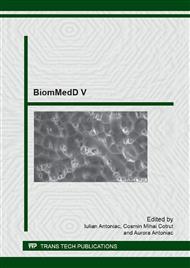p.125
p.129
p.137
p.145
p.150
p.155
p.163
p.169
p.175
New Devices for Optimization of Renoureteral Lithiasis Treatment Using ESWL
Abstract:
In the case of renoureteral lithiasis, shockwave lithotripsy (ESWL) proved to be an effective and safe method with a low risk of significant clinical consequences for long term The therapeutic effect is the result of the pulse amplitude, high pressure and shock wave energy content focused on striking stones or urethral calculi. The negative pressure specific shock wave is responsible for the phenomenon of cavitation. Cavitation plays an important role in the fragmentation of calculus as the technical components accelerates wear mechanism for generating shock waves in special electrode (the electrohydraulic generator). The main objective of this study is to find technical solutions in terms of improving energy transfer shock waves from the generator to the target and reliability/optimization of the shock wave generator (the electrohydraulic lithotriptor EHL vulnerable point).
Info:
Periodical:
Pages:
155-159
Citation:
Online since:
September 2013
Keywords:
Price:
Сopyright:
© 2014 Trans Tech Publications Ltd. All Rights Reserved
Share:
Citation:


